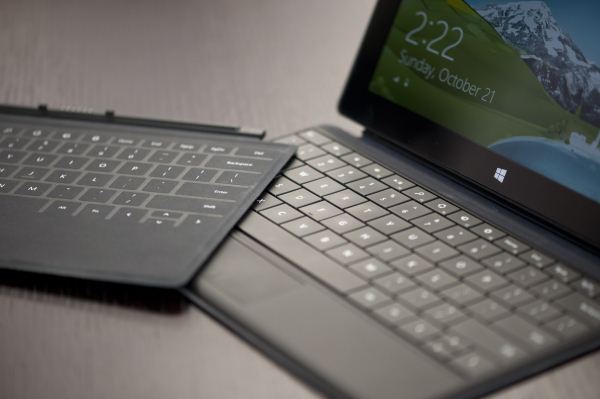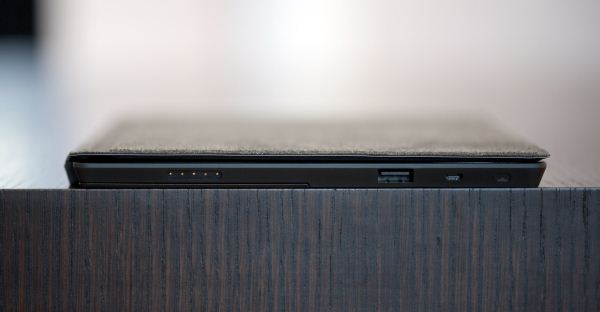Microsoft Surface Review
by Anand Lal Shimpi on October 23, 2012 9:01 PM EST- Posted in
- Tablets
- Microsoft
- Mobile
- Surface
- Windows RT
Type Cover
If Microsoft’s Touch Cover is the perfect companion for occasional typing, its Type Cover is the professional counterpart. Thickness increases by roughly 2.2mm, enough to be noticeable while still maintaining the svelte profile of Surface, but in exchange for marginally more bulk you get a keyboard with actuating scissor keys.
The keys themselves are a little bigger than in Touch Cover, thus reducing the amount of empty space between each key, but overall the feel is very similar. Where Type Cover really delivers is in its use of scissor keys. If you want more of a notebook feel, this is the way to go.
Typing quickly on Type Cover isn’t fatiguing at all and it’s just as easy to write large documents or emails using it as it would be on a traditional notebook. There are very few tradeoffs that you make to enjoy Type Cover. There’s only one color (black), and of course there is some additional thickness. The keyboard itself isn’t perfect but it’s good enough to write this review on.
I actually wasn’t bothered by the relatively shallow keystroke depth on Type Cover, although I am very used to the relatively shallow feel of most ultraportable keyboards by now. If you’re expecting the same sort of keyboard as you’d find on a thick mainstream notebook, you will be disappointed.
Type Cover’s trackpad is marginally better than what you get with Touch Cover. The trackpad is actually a tiny, top-hinged clickpad, which makes clicking a bit easier. Tap to click and two finger scrolling are both supported. The trackpad surface isn’t particularly smooth, and it isn’t all that large of a surface which work together to make scrolling nice and frustrating. The lower right section of the trackpad serves as a physical right mouse button.
Type Cover sells at a $10 premium to Touch Cover. At $129 it isn’t cheap, but it’s likely the option anyone who is going to do a lot of typing will need to take to get the most out of their Surface RT tablet.
My only complaint with Type Cover was that it would randomly stop accepting keystrokes in mid sentence, sometimes even in the middle of a word. I’m not entirely sure what’s going on, whether I’m hitting performance limitations and the platform is just dropping keystrokes or if there’s a physical problem with my unit (or Type Cover in general), but it was annoying. Even with the occasional dropped keystrokes I was still able to type faster and better on Type Cover than I could with Touch Cover. If you write for a living, you can live with Touch Cover, but you’d probably rather have Type Cover. Neither is as good as a traditional notebook keyboard, but both are light years ahead of typing on a glass screen.
















235 Comments
View All Comments
Shadowmaster625 - Wednesday, October 24, 2012 - link
Doesnt it bother you that simply typing a vanilla document in Office uses so much cpu power. You think they are ever going to fix that? What happens when you give it access to much more cpu resources? Will it simply consume it all?andrewaggb - Wednesday, October 24, 2012 - link
Both Anand and Vivek said it keeps up though, which is the main thing I think. And these are guys who type for a living. Really it drives home that anything slower than tegra 3 wouldn't cut it and tegra 3 is barely fast enough.As for what happens when you give it more cpu, how does word run on your current desktop? On my first gen core i7 laptop (dual core), I can get word up to 4% cpu in task mgr by key bashing.
I'd be very interested in seeing what battery life and video performance an atom based tablet gets.
robmuld - Wednesday, October 24, 2012 - link
The choice of 16:9 for the display just tells me Microsoft will never get itN4g4rok - Wednesday, October 24, 2012 - link
Have you looked at the Pro version spec sheet?WP7Mango - Wednesday, October 24, 2012 - link
Actually, Microsoft DO get it. There are 3 reasons why 16:9 is preferable -1. It allows for the Windows 8 / RT multitasking feature - two apps snapped side by side, with one app taking up a thin column whilst the other app taking up a larger portion. These can be swapped round just by dragging the seperator between them. Even the desktop can be snapped with a metro app this way. It's an elegant solution to multitasking on a tablet, and a feature that the iPad doesn't have.
2. It's the ideal size for watching movies whilst minimising black borders.
3. The extra horizonal screen space gives you more flexibility in terms of app UI capabilities.
ET - Wednesday, October 24, 2012 - link
I think it's a pity that Microsoft doesn't allow running .NET apps on the desktop interface. That would have made Window RT comparable to Windows 8 and allowed using the Surface as a full PC, with a decent choice of software already available.jamawass - Wednesday, October 24, 2012 - link
Interesting review. Does the usb port support cameras? Can pictures be transferred from a camera to the surface as on a desktop?WP7Mango - Wednesday, October 24, 2012 - link
Yes, the USB port does support cameras. Yes, pictures can be transferred from a camera to the Surface just like you can on a desktop PC.karasaj - Wednesday, October 24, 2012 - link
I don't know if you're still answering questions Anand (or any staff) but do you think Surface RT would suffice for a university student who just needs to rapidly type on Microsoft office for ~50 minutes without it feeling sluggish at all? That and streaming netflix are probably all that I need to do with Surface, if I can do that, then I'd pay for surface over an ultrabook (i.e. vizio ct14-a0) for the portability and battery life.B3an - Thursday, October 25, 2012 - link
I think Surface would be the best option for that kind of stuff. It's perfectly suited for it. My brother is at uni and wants the same kind of thing, and he's getting a Surface.